Why do we collect things?
The objects we collect are another way we remember: they help us learn about the past and how things have changed over time.

The Memorial's collection includes many amazing objects past and present, including this Avro 504K trainer from the First World War.
🔥 Hot tip By borrowing one of our Memorial Boxes you can add real hands-on objects and uniform items to the lesson, bringing the past to life. They're free to use so why not book one now?
What makes objects special?
Encourage students to bring in something that is special to them to share with the class.
Where did you get this object?
How do you look after it?
During the war, Charles Bean noticed the Australian soldiers often collected things from places they fought or visited. This was something he actively encouraged. In fact, a special team was set up just to collect all the objects and records together. Charles was already thinking about how his Memorial might display all these objects.
What sorts of things can you find in a museum?
How might a these things help Australians to remember?
Without television or internet, Australians only heard about the war through newspapers and black & white photographs. Charles hoped that if his Memorial was full of real objects and relics of the war, people would have a better sense of what it had been like. They might be able to put themselves in the shoes of those who were there.
The video below demonstrates how the Education team here at the Memorial might use some collection objects with a younger audience.
How do these objects tell stories?
Take a close look at this object. What does it tell about the past?
This pocket watch belonged to an Australian soldier in the First World War named Robert Hartley. Robert and his comrades were among the first Anzacs to arrive on Gallipoli, shortly before dawn. He was in a boat, getting close to the beach, when he jumped overboard and began wading ashore. He landed in water so deep that his watch was soaked in seawater. As a result, it stopped. The hands on the watch were frozen in time at the moment he hit the water: 4.43 a.m.

Towed lifeboats carried the soldiers to Anzac Cove in several waves. This photograph was taken at 6 am on the day of the landing.
Robert survived Gallipoli, and the rest of the war, returning home to Australia in November 1918. But he never fixed his watch, which was now rusty inside. He did, however, treasure it and keep it with him for a long time.
Why would he keep a broken watch?
Many years later, Robert gave the watch to the Australian War Memorial, and it became part of the Memorial’s collection.
If the watch was so special, why might Robert have given it away like this?
Changes over time
Ever since Charles Bean and the First World War, the Memorial has never stopped collecting objects and telling the stories of Australians during war, and so a vast collection exists spanning over 100 years. We can look back through time at objects with similar functions and see how they've changed. The slideshow below is an example using uniforms.
Which uniform do you think is the the oldest/newest? Why?
What differences can you see?
Activities

Mystery object
Bring in something old and unusual; students must try to guess what it is. What does it say about how people used to live?

Make a time capsule
As a class, select six objects that best describe 2017 for people in the future.
